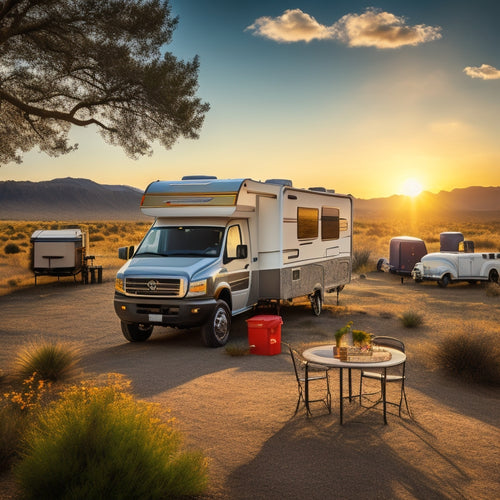
5 Best Inverters for DIY Renewable Energy Systems
Share
When building a DIY renewable energy system, you need an inverter that integrates seamlessly with your setup. Look for top smart solar inverters that prioritize grid resilience and feature advanced monitoring and control capabilities. Efficiency is key, so opt for models with ratings above 95%. Confirm compatibility with your system's voltage and current ratings, and consider built-in MPPT for solar panels. Remote monitoring and proactive maintenance features are also essential. If you're on a budget, consider modified sine wave inverters or open-source projects. To find the perfect inverter for your DIY system, consider these key factors and explore your options further.
Key Takeaways
• Prioritize high-efficiency inverters with ratings above 95% to minimize energy loss and maximize energy yield in DIY renewable energy systems.
• Ensure the inverter is compatible with your renewable energy system, considering voltage and current ratings, communication protocols, and certifications.
• Opt for inverters with advanced monitoring and control capabilities, including remote monitoring and automated alerts, to proactively maintain peak efficiency.
• Consider budget-friendly inverter solutions, such as modified sine wave or entry-level pure sine wave inverters, and utilize inverter sizing software for cost optimization.
• Look for inverters with built-in Wi-Fi or cellular connectivity and real-time tracking and optimization of energy production to ensure seamless integration with your DIY renewable energy system.
Top Smart Solar Inverter Options
Your search for the ideal smart solar inverter ends with these top options, each boasting advanced features to optimize your DIY renewable energy system's performance.
As you explore the best inverter for your project, consider those that prioritize grid resilience, ensuring your system remains operational even during grid outages. This level of reliability is critical for energy democracy, where individuals and communities take control of their energy generation and consumption.
Inverters that excel in grid resilience often feature advanced monitoring and control capabilities, enabling real-time tracking and optimization of your energy production. Look for inverters with built-in Wi-Fi or cellular connectivity, allowing for seamless monitoring and remote updates.
Additionally, consider inverters with built-in energy storage integration, enabling you to store excess energy generated during the day for use during periods of low sunlight or grid outages.
Inverter Efficiency and Power Output
When selecting an inverter for your DIY renewable energy system, it's important to consider the inverter's efficiency and power output, as these factors directly impact the system's overall performance and energy yield.
You'll want an inverter that can efficiently convert DC power from your renewable energy sources to AC power for your home or business. Look for an inverter with a high maximum output to make sure you're getting the most out of your energy harvesting efforts.
Inverter efficiency is typically measured by its capacity to convert DC power to AC power while minimizing energy loss as heat. A higher efficiency rating means more of the energy generated by your renewable sources is being used to power your home or business, rather than being wasted as heat.
When evaluating inverters, look for models with high efficiency ratings, typically above 95%, to maximize your energy yield. By choosing an inverter with high efficiency and maximum output, you'll be able to harness the full potential of your renewable energy system and reduce your reliance on the grid.
Compatibility With Renewable Energy Systems
To guarantee smooth integration with your renewable energy system, it's crucial to select an inverter that's compatible with your specific setup, including the type and number of solar panels or wind turbines. When choosing an inverter, you'll want to make sure it can efficiently manage the energy harvesting process.
Here are some key considerations for system integration:
-
Voltage and current ratings: Confirm the inverter can handle the voltage and current output of your renewable energy sources.
-
Communication protocols: Check if the inverter supports the same communication protocols as your energy harvesting devices (e.g., Modbus, CANbus, or RS-485).
-
Maximum power point tracking (MPPT): If you're using solar panels, look for an inverter with built-in MPPT to optimize energy harvesting.
- Certifications and compliance: Verify the inverter meets relevant industry standards and regulations for your region.
Monitoring and Maintenance Features
You'll also want an inverter that provides monitoring and maintenance features to guarantee your renewable energy system operates at peak efficiency. This is essential to make sure that your system is running smoothly and producing the maximum amount of energy possible.
With remote monitoring capabilities, you can keep an eye on your system's performance from anywhere, at any time. This feature allows you to identify potential issues before they become major problems, reducing downtime and increasing overall efficiency.
Automated alerts can also be set up to notify you of any system faults or errors, enabling you to take prompt action to rectify the issue. This proactive approach to maintenance ensures that your system is always running at its best, maximizing your energy output and reducing your reliance on the grid.
Budget-Friendly Inverter Solutions
If budget constraints are a concern, you can still find reliable inverter solutions that won't break the bank. As you explore options for your DIY renewable energy system, take into account the following budget-friendly inverter solutions:
-
Modified Sine Wave Inverters: A cost-effective option for small off-grid systems, modified sine wave inverters provide a reliable power source for basic appliances.
-
Entry-Level Pure Sine Wave Inverters: Offering better performance than modified sine wave inverters, entry-level pure sine wave inverters are suitable for small to medium-sized off-grid systems.
-
Inverter Sizing Software: Utilize free inverter sizing software to optimize your system's performance and reduce costs by right-sizing your inverter.
- Open-Source Inverter Projects: Explore open-source inverter projects that provide affordable and customizable solutions for DIY enthusiasts.
When selecting a budget-friendly inverter solution, keep in mind your system's specific needs, including inverter sizing, to guarantee a reliable and efficient power supply for your off-grid system.
Frequently Asked Questions
Can I Install an Inverter Myself, or Do I Need a Professional?
'Are you a thrill-seeker, keen to conquer the world of DIY projects? Installing an inverter yourself may seem tempting, but safety concerns and complex electrical connections make it advisable to seek a professional's expertise.'
How Long Does a Typical Inverter Last Before Needing Replacement?
You can expect a typical inverter to last around 10-15 years, depending on Inverter Maintenance and environmental factors. Most manufacturers offer a 5-10 year Product Warranty, giving you peace of mind and protection for your investment.
Are Inverters Compatible With Generators or Only Renewable Energy?
You'll be glad to know that many modern inverters are designed to be compatible with both generators and renewable energy sources, offering energy flexibility and allowing you to switch between power sources seamlessly.
Do I Need a Separate Inverter for Each Renewable Energy Source?
As you consider harnessing renewable energy, imagine 70% of the world's population relying on off-grid power by 2050. You don't need a separate inverter for each source; instead, design a system that combines sources, using a single inverter for your Source Combination.
Can I Use a Single Inverter for Both On-Grid and Off-Grid Systems?
You can use a single inverter for both on-grid and off-grid systems, but it depends on the inverter's flexibility and your system design; look for inverters with hybrid or multi-mode capabilities to guarantee smooth switches.
Related Posts
-

Top Portable Solar Panels for Cars to Buy Online
When shopping for portable solar panels for your car, you'll want to take into account reputable brands like Renogy, ...
-

What You Need to Know About RV Solar Maintenance
When you're out on the road, your RV's solar panel system is your lifeline. But without regular maintenance, you're l...
-

Planning for an Electric Vehicle-Friendly Urban Future
As you plan for an electric vehicle-friendly urban future, you'll need to integrate high-power charging stations, sma...


